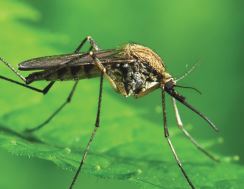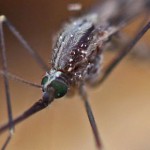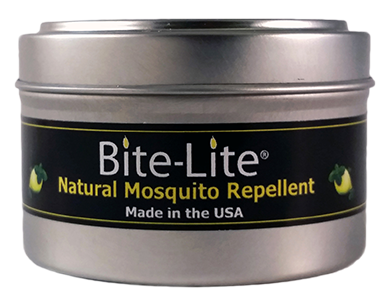 Mosquitoes are insects belonging to the order Diptera, the True Flies. Like all True Flies, mosquitoes have two wings, but unlike other flies, mosquitoes have wings with scales. The mouthparts of female mosquitoes form a long piercing-sucking proboscis. Males differ from females by having feathery antennae and mouthparts not suitable for piercing skin. A mosquito’s principal food is nectar or similar sugar source.
There are over 3,000 different species of mosquitoes throughout the world; currently 176 species are recognized in the United States. A new species, Anopheles grabhamii, was reported from the Florida Keys in 2001 (Darsie et al. 2002). Each mosquito species has a Latin scientific name, such as Anopheles quadrimaculatus. Anopheles is the “generic” name of a group of closely related mosquitoes; quadrimaculatus is the “species” name that represents a group of individuals that are similar in structure and physiology and capable of interbreeding. These names are used in a descriptive manner so that the name tells something about each particular mosquito. For example, Anopheles means hurtful or prejudicial in Greek; quadrimaculatus means four spots (4 dark spots on the wings) in Latin. Some species have what are called “common names” as well as scientific names, such as Ochlerotatus taeniorhynchus, the “black salt marsh mosquito.”
Scientific investigators (taxonomists) are constantly looking for new mosquitoes, as well as reviewing previously identified specimens for new information or identifying characteristics. Better microscopic equipment developed in the last 20 years has improved the taxonomist’s ability to determine differences between species. Recently such a review by Dr. John Reinert (2000) led to a change in the name of many mosquitoes belonging to the genus Aedes. Using improved methods and over 30 years’ experience, he elevated a subgenus of Aedes ( Ochlerotatus ) to the status of genus. This will necessitate the renaming of many mosquitoes previously named Aedes to the genus Ochlerotatus and the rewriting of many taxonomic keys important to public health entomologists working in mosquito control.
”
The Spanish called mosquitoes “musketas,” and the native Hispanic Americans called them “zancudos.” “Mosquito” is a Spanish or Portuguese word meaning “little fly” while “zancudos,” a Spanish word, means “long-legged.” The use of the word “mosquito” is apparently of North American origin and dates back to about 1583. In Europe, mosquitoes were called “gnats” by the English, “Les moucherons” or “Les cousins” by French writers, while the Germans used the name “Stechmucken” or “Schnacke.” In Scandinavian countries mosquitoes were called by a variety of names including “myg” and “myyga.” and the Greeks called them “konopus.” In 300 B.C., Aristotle referred to mosquitoes as “empis” in his “Historia Animalium” where he documented their life cycle and metamorphic abilities. Modern writers used the name Culex, and it is retained today as the name of a mosquito genus. What is the correct plural form of the word mosquito? In Spanish it would be “mosquitos,” but in English “mosquitoes” (with the “e”) is correct.
Mosquitoes can be an annoying, serious problem in man’s domain. They interfere with work and spoil hours of leisure time. Their attacks on farm animals can cause loss of weight and decreased milk production. Some mosquitoes are capable of transmitting diseases such as malaria, yellow fever, dengue, filariasis, and encephalitis [St. Louis encephalitis (SLE)], Western Equine encephalitis (WEE), LaCrosse encephalitis (LAC), Japanese encephalitis (JE), Eastern Equine encephalitis (EEE), and West Nile virus (WNV)] to humans and animals.
Mosquitoes are insects belonging to the order Diptera, the True Flies. Like all True Flies, mosquitoes have two wings, but unlike other flies, mosquitoes have wings with scales. The mouthparts of female mosquitoes form a long piercing-sucking proboscis. Males differ from females by having feathery antennae and mouthparts not suitable for piercing skin. A mosquito’s principal food is nectar or similar sugar source.
There are over 3,000 different species of mosquitoes throughout the world; currently 176 species are recognized in the United States. A new species, Anopheles grabhamii, was reported from the Florida Keys in 2001 (Darsie et al. 2002). Each mosquito species has a Latin scientific name, such as Anopheles quadrimaculatus. Anopheles is the “generic” name of a group of closely related mosquitoes; quadrimaculatus is the “species” name that represents a group of individuals that are similar in structure and physiology and capable of interbreeding. These names are used in a descriptive manner so that the name tells something about each particular mosquito. For example, Anopheles means hurtful or prejudicial in Greek; quadrimaculatus means four spots (4 dark spots on the wings) in Latin. Some species have what are called “common names” as well as scientific names, such as Ochlerotatus taeniorhynchus, the “black salt marsh mosquito.”
Scientific investigators (taxonomists) are constantly looking for new mosquitoes, as well as reviewing previously identified specimens for new information or identifying characteristics. Better microscopic equipment developed in the last 20 years has improved the taxonomist’s ability to determine differences between species. Recently such a review by Dr. John Reinert (2000) led to a change in the name of many mosquitoes belonging to the genus Aedes. Using improved methods and over 30 years’ experience, he elevated a subgenus of Aedes ( Ochlerotatus ) to the status of genus. This will necessitate the renaming of many mosquitoes previously named Aedes to the genus Ochlerotatus and the rewriting of many taxonomic keys important to public health entomologists working in mosquito control.
”
The Spanish called mosquitoes “musketas,” and the native Hispanic Americans called them “zancudos.” “Mosquito” is a Spanish or Portuguese word meaning “little fly” while “zancudos,” a Spanish word, means “long-legged.” The use of the word “mosquito” is apparently of North American origin and dates back to about 1583. In Europe, mosquitoes were called “gnats” by the English, “Les moucherons” or “Les cousins” by French writers, while the Germans used the name “Stechmucken” or “Schnacke.” In Scandinavian countries mosquitoes were called by a variety of names including “myg” and “myyga.” and the Greeks called them “konopus.” In 300 B.C., Aristotle referred to mosquitoes as “empis” in his “Historia Animalium” where he documented their life cycle and metamorphic abilities. Modern writers used the name Culex, and it is retained today as the name of a mosquito genus. What is the correct plural form of the word mosquito? In Spanish it would be “mosquitos,” but in English “mosquitoes” (with the “e”) is correct.
Mosquitoes can be an annoying, serious problem in man’s domain. They interfere with work and spoil hours of leisure time. Their attacks on farm animals can cause loss of weight and decreased milk production. Some mosquitoes are capable of transmitting diseases such as malaria, yellow fever, dengue, filariasis, and encephalitis [St. Louis encephalitis (SLE)], Western Equine encephalitis (WEE), LaCrosse encephalitis (LAC), Japanese encephalitis (JE), Eastern Equine encephalitis (EEE), and West Nile virus (WNV)] to humans and animals.
 We would like consumers to know what we are all about while they are shopping for mosquito control products. What distinguishes Bite-Lite® from the rest?
We would like consumers to know what we are all about while they are shopping for mosquito control products. What distinguishes Bite-Lite® from the rest? 
 Mosquitoes are insects belonging to the order Diptera, the True Flies. Like all True Flies, mosquitoes have two wings, but unlike other flies, mosquitoes have wings with scales. The mouthparts of female mosquitoes form a long piercing-sucking proboscis. Males differ from females by having feathery antennae and mouthparts not suitable for piercing skin. A mosquito’s principal food is nectar or similar sugar source.
There are over 3,000 different species of mosquitoes throughout the world; currently 176 species are recognized in the United States. A new species, Anopheles grabhamii, was reported from the Florida Keys in 2001 (Darsie et al. 2002). Each mosquito species has a Latin scientific name, such as Anopheles quadrimaculatus. Anopheles is the “generic” name of a group of closely related mosquitoes; quadrimaculatus is the “species” name that represents a group of individuals that are similar in structure and physiology and capable of interbreeding. These names are used in a descriptive manner so that the name tells something about each particular mosquito. For example, Anopheles means hurtful or prejudicial in Greek; quadrimaculatus means four spots (4 dark spots on the wings) in Latin. Some species have what are called “common names” as well as scientific names, such as Ochlerotatus taeniorhynchus, the “black salt marsh mosquito.”
Scientific investigators (taxonomists) are constantly looking for new mosquitoes, as well as reviewing previously identified specimens for new information or identifying characteristics. Better microscopic equipment developed in the last 20 years has improved the taxonomist’s ability to determine differences between species. Recently such a review by Dr. John Reinert (2000) led to a change in the name of many mosquitoes belonging to the genus Aedes. Using improved methods and over 30 years’ experience, he elevated a subgenus of Aedes ( Ochlerotatus ) to the status of genus. This will necessitate the renaming of many mosquitoes previously named Aedes to the genus Ochlerotatus and the rewriting of many taxonomic keys important to public health entomologists working in mosquito control.
”
The Spanish called mosquitoes “musketas,” and the native Hispanic Americans called them “zancudos.” “Mosquito” is a Spanish or Portuguese word meaning “little fly” while “zancudos,” a Spanish word, means “long-legged.” The use of the word “mosquito” is apparently of North American origin and dates back to about 1583. In Europe, mosquitoes were called “gnats” by the English, “Les moucherons” or “Les cousins” by French writers, while the Germans used the name “Stechmucken” or “Schnacke.” In Scandinavian countries mosquitoes were called by a variety of names including “myg” and “myyga.” and the Greeks called them “konopus.” In 300 B.C., Aristotle referred to mosquitoes as “empis” in his “Historia Animalium” where he documented their life cycle and metamorphic abilities. Modern writers used the name Culex, and it is retained today as the name of a mosquito genus. What is the correct plural form of the word mosquito? In Spanish it would be “mosquitos,” but in English “mosquitoes” (with the “e”) is correct.
Mosquitoes can be an annoying, serious problem in man’s domain. They interfere with work and spoil hours of leisure time. Their attacks on farm animals can cause loss of weight and decreased milk production. Some mosquitoes are capable of transmitting diseases such as malaria, yellow fever, dengue, filariasis, and encephalitis [St. Louis encephalitis (SLE)], Western Equine encephalitis (WEE), LaCrosse encephalitis (LAC), Japanese encephalitis (JE), Eastern Equine encephalitis (EEE), and West Nile virus (WNV)] to humans and animals.
Mosquitoes are insects belonging to the order Diptera, the True Flies. Like all True Flies, mosquitoes have two wings, but unlike other flies, mosquitoes have wings with scales. The mouthparts of female mosquitoes form a long piercing-sucking proboscis. Males differ from females by having feathery antennae and mouthparts not suitable for piercing skin. A mosquito’s principal food is nectar or similar sugar source.
There are over 3,000 different species of mosquitoes throughout the world; currently 176 species are recognized in the United States. A new species, Anopheles grabhamii, was reported from the Florida Keys in 2001 (Darsie et al. 2002). Each mosquito species has a Latin scientific name, such as Anopheles quadrimaculatus. Anopheles is the “generic” name of a group of closely related mosquitoes; quadrimaculatus is the “species” name that represents a group of individuals that are similar in structure and physiology and capable of interbreeding. These names are used in a descriptive manner so that the name tells something about each particular mosquito. For example, Anopheles means hurtful or prejudicial in Greek; quadrimaculatus means four spots (4 dark spots on the wings) in Latin. Some species have what are called “common names” as well as scientific names, such as Ochlerotatus taeniorhynchus, the “black salt marsh mosquito.”
Scientific investigators (taxonomists) are constantly looking for new mosquitoes, as well as reviewing previously identified specimens for new information or identifying characteristics. Better microscopic equipment developed in the last 20 years has improved the taxonomist’s ability to determine differences between species. Recently such a review by Dr. John Reinert (2000) led to a change in the name of many mosquitoes belonging to the genus Aedes. Using improved methods and over 30 years’ experience, he elevated a subgenus of Aedes ( Ochlerotatus ) to the status of genus. This will necessitate the renaming of many mosquitoes previously named Aedes to the genus Ochlerotatus and the rewriting of many taxonomic keys important to public health entomologists working in mosquito control.
”
The Spanish called mosquitoes “musketas,” and the native Hispanic Americans called them “zancudos.” “Mosquito” is a Spanish or Portuguese word meaning “little fly” while “zancudos,” a Spanish word, means “long-legged.” The use of the word “mosquito” is apparently of North American origin and dates back to about 1583. In Europe, mosquitoes were called “gnats” by the English, “Les moucherons” or “Les cousins” by French writers, while the Germans used the name “Stechmucken” or “Schnacke.” In Scandinavian countries mosquitoes were called by a variety of names including “myg” and “myyga.” and the Greeks called them “konopus.” In 300 B.C., Aristotle referred to mosquitoes as “empis” in his “Historia Animalium” where he documented their life cycle and metamorphic abilities. Modern writers used the name Culex, and it is retained today as the name of a mosquito genus. What is the correct plural form of the word mosquito? In Spanish it would be “mosquitos,” but in English “mosquitoes” (with the “e”) is correct.
Mosquitoes can be an annoying, serious problem in man’s domain. They interfere with work and spoil hours of leisure time. Their attacks on farm animals can cause loss of weight and decreased milk production. Some mosquitoes are capable of transmitting diseases such as malaria, yellow fever, dengue, filariasis, and encephalitis [St. Louis encephalitis (SLE)], Western Equine encephalitis (WEE), LaCrosse encephalitis (LAC), Japanese encephalitis (JE), Eastern Equine encephalitis (EEE), and West Nile virus (WNV)] to humans and animals. We have spent lifetimes defining the elusive chemistry between people. Artists have painted pictures, and poets have dedicated sonnets.
We have spent lifetimes defining the elusive chemistry between people. Artists have painted pictures, and poets have dedicated sonnets. With 200 species of mosquitoes in North America and over 2500 species worldwide, we should have guessed they would evolve and conquer the cold weather.
With 200 species of mosquitoes in North America and over 2500 species worldwide, we should have guessed they would evolve and conquer the cold weather.
